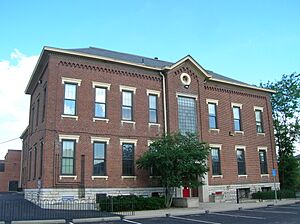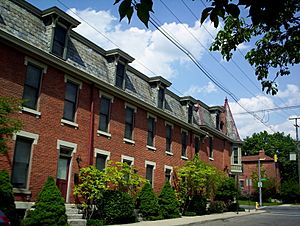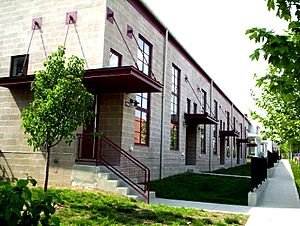Italian Village facts for kids
Quick facts for kids
Italian Village
|
|
|---|---|
|
Neighborhood of Columbus
|
|
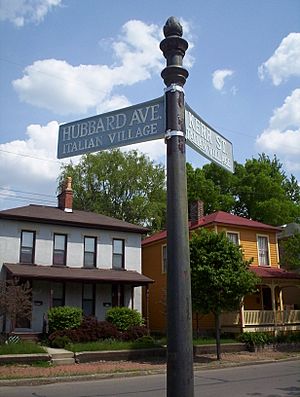
Signage at Hubbard and Kerr on the corner of Italian Village Park
|
|
| Country | United States |
| State | Ohio |
| County | Franklin |
| City | Columbus |
| ZIP Code |
43201 and 43215
|
| Area code(s) | 614 |
Italian Village is a neighborhood in Columbus, Ohio. It has many homes, shops, and factories. This area is a special historic district. This means its old buildings and culture are protected. The buildings and their designs show a strong Italian influence. Italian Village also has parks and old homes. Because of this, it has the highest increase in home values in Columbus.
Italian Village is part of the Short North area. It is close to the Downtown district. This gives people easy access to many jobs, cultural places, and fun entertainment spots.
Contents
Where is Italian Village Located?
Italian Village is in the northern part of Columbus, Ohio. It is just north of the Downtown area. The neighborhood has clear borders. Interstate 670 is to the south. Fifth Avenue is to the north. North High Street is to the west. The Conrail railroad tracks are to the east.
The streets in Italian Village are set up in a grid pattern. This means they cross each other at right angles. N. Fourth Street, E. Fifth Avenue, and E. Second Avenue are the main roads. N. Fourth Street is a key route through downtown. E. Fifth Avenue crosses both the Scioto and Olentangy Rivers. Both of these main roads have homes, shops, offices, and factories.
How is the Land Used?
Most of the buildings in Italian Village are homes. About 80% are houses. These include single-family homes, double houses, and row houses. Most homes are not too close together. They are found in the northwest and along the main roads.
About 10% of the buildings are shops. These are mostly along N. Fourth Street and E. Fifth Avenue. There are also factories scattered around the area. Most factories are east of N. Sixth Street and north of E. Second Avenue. Others are along N. Fourth Street and E. Fifth Avenue.
The City of Columbus has a special program for Italian Village. It helps new building projects. If a project includes homes that people can afford, it can get tax breaks for 15 years.
A Look Back: Italian Village History
Italian Village was one of the first areas outside of downtown Columbus. The land was empty until a road called the Columbus-Worthington Pike (now High Street) was built in 1823. This road helped people move into the area. Italian Village officially became part of Columbus in 1862.
The North Columbus Street Railway Company helped the area grow. Streetcar service made it easier to travel. By 1899, there was a good street system. It even had many alleys for horse stables behind the homes. In the early 1900s, Italian Village was a strong middle-class neighborhood. Being close to downtown meant people had easy access to shops, services, and fun places. It also offered many job opportunities. Electric trolleys took residents to places they couldn't walk to.
Who Lived Here?
Italian Village was once a neighborhood for immigrants. It got its name because many Italian immigrants lived there. But Italians were not the first group, nor the only one. From about 1850 to 1870, Irish people lived in the southern part of the village. They also lived around Naughten Street (now Goodale Boulevard), which was called "Irish Broadway."
After the Irish left, African American migrants moved to Italian Village. They came for jobs, often in railroad and iron factories. A small group of African Americans settled in the northeast part of the village. They started the Bethany Baptist Colored Church in 1882.
Later, Italians came to the neighborhood for jobs they could walk to. In the 1890s, the first Italian immigrants moved from Flytown to Italian Village. They worked in stone quarries, construction, railroads, and local shops on High Street. Italian builders helped make the beautiful buildings and unique style of Italian Village. In 1896, St. John the Baptist Italian Catholic Church was founded. It helped create a strong Italian-American community. During the Great Depression, Italian food became popular because it was cheaper to grow. This food was sold at local restaurants and small grocery stores in Italian Village.
Jobs in the Neighborhood
At its busiest time, Italian Village had about 6,000 jobs within walking distance of the historic Italian Catholic Church. The Jeffrey Manufacturing Company was a huge employer. It made equipment for coal mining. Located at 274 East First Avenue, it once had 3,400 employees. This made it the largest single employer in Columbus.
Other big employers included:
- The Clark Grave Vault/Clark Auto Equipment Company: 1,200 employees.
- Smith Brothers Hardware Company: 500 employees.
- The Berry Bolt Works: 240 employees.
- Case Crane, Kilbourne & Jacobs Company: 200 employees.
- Radio Cab Company and Columbus Burlap Bag Company: 200 employees combined.
Many other smaller businesses also offered jobs.
Challenges and Comeback
Italian Village was very successful in the 1940s. But after World War II, things changed. People started moving to the suburbs. Families with less money moved into Italian Village. Some had to move because their old neighborhoods were being torn down. Large homes were divided into many smaller apartments.
As homes declined, so did local businesses. The new residents did not have enough money to support the shops on High Street. In the early 1950s, parts of Italian Village were cleared for new roads and city improvements. This caused more buildings to be torn down. The number of people living in Italian Village also went down. Schools like Sacred Heart Grade School and High School closed in 1973.
People who lived in the neighborhood were worried about losing their historic buildings. They decided to act. In 1973, they formed the Italian Village Society. Their goal was to protect the historic value of the area. The Columbus City Council then created the Italian Village Commission. This group also worked to fix up the neighborhood.
In 1974, the "Italian Village Development Plan" was created. Volunteers and students from Ohio State University helped. The plan looked at problems and suggested fixing old buildings. It also proposed new parks, better transportation, and stronger housing rules. The Italian Village Society and Commission helped build a strong community spirit. By the early 1980s, Italian Village started to attract middle-income families again. This comeback helped the Short North area earn the "All American City" award.
The neighborhood's Second Avenue Elementary School was built in 1874. It is one of the oldest school buildings still standing in Columbus.
Important Buildings and Places
St. John the Baptist Italian Catholic Church
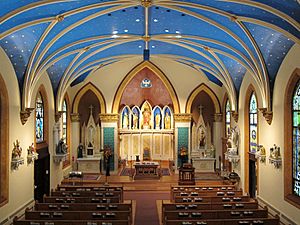
Italian Village might have gotten its name from St. John the Baptist Italian Catholic Church. The church was founded in 1896 and built two years later. It became the most important and recognizable building in Italian Village. Many members came from Columbus’ Italian immigrant community.
The church's goal was to bring Italian immigrants together. It gave them a place to worship in their own language. It also allowed them to follow traditions from their homes in Italy. St. John's became the heart of the Italian Catholic community. Even today, people walk to church in big parades on special feast days. These include the feast day of St. John the Baptist. Italian is still spoken in the church halls after Mass. But newer generations, born in America, are slowly replacing the older Italian-born members.
The Berry Brothers Bolt Works Building
The Berry Brothers Bolt Works building was built in 1888. It is still one of Columbus’ most famous factory buildings. It was named a historic site in 1988. The National Register of Historic Places recognized it for its design, history, and potential as an old industrial site.
When it was running, the factory used old machines to make tools like bolts. These bolts were used in factories that built buggies. Berry Brothers kept making bolts even when cars replaced buggies. By 2004, the building was in bad shape. A company called Capital Equities bought it and fixed it up. Now, the building is a busy office complex.
Jeffrey Mining Administrative Office Building
The Jeffrey Manufacturing Company made equipment for coal mining. It was a very big employer in Italian Village in the early 1900s. Located along North Fourth Street, it had over 3,000 employees. At one time, it was the largest single employer in Columbus. The administrative building where the company was run still stands today. This makes it a historic landmark in Italian Village.
Italian Village Park
Italian Village Park is a public park within the neighborhood. It honors Carl Proto, who was from Columbus. The park is in the center of the area. It has a playground and places for picnics. The Italian Village Park Committee takes care of the park. They accept donations and share updates with residents. Recent donations have helped plant flowers and keep the lawn mowed.
What Does Italian Village Look Like?
Italian Village is special because of its old buildings. It also has narrow brick streets. There are nice features for people walking, like old trees and front porches. The neighborhood's unique style also comes from Italian design. This can be seen in the common architecture.
Homes in Italian Village
Homes in Italian Village are mostly influenced by Italianate and Queen Anne styles. The Italianate style has tall, narrow shapes and low roofs. It often has fancy brackets under the roof and decorative wood on porches. Queen Anne style homes have steep, uneven roofs. They also have different window designs.
In Italian Village, homes are built on narrow plots of land. They are close to each other and close to the street. There are alleys behind the houses. Most houses are two to two and a half stories tall. They often have hipped or gabled roofs, which are common in Italianate style. Rowhouses are made of brick with flat roofs and Italianate decorations. The American Four Square House is also common. It shows Italian design elements like the hipped roof and a wide front porch.
Shops and Factories
Some commercial buildings show Italianate or Victorian styles. But many were changed after High Street was made wider in 1920. These buildings are usually two to four stories tall. They have a shop on the ground floor. The upper floors look like homes with evenly spaced windows. Most are built with brick, stone, or metal.
Most factories are also two to four stories tall. They are built with the same materials and have many windows. Some factories have brackets or decorative brickwork. These details show the Italianate style.
Fun Things to Do
Alfonso Pishtelli, one of the first people to live in Italian Village, remembered going to concerts at Goodale Park. He also went to Italian festivals on St. Clair Avenue with his family. He said people "looked forward to Saturdays because typically it would be mostly weddings when people [could] get together.”
The Columbus Italian Festival is still held today. The Italian Village Society also hosts Holiday Potlucks. "Salsa Saturdays" are held on Lincoln Street. Italian Village has many local restaurants, bars, and art galleries.
The neighborhood also offers other fun things in the Short North area. These include theaters, farmers markets, and small parks. Nearby, Downtown Columbus has Nationwide Arena and the Columbus Convention Center.
Gallery


